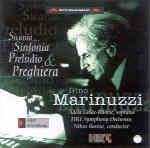To the extent that he is known at all today, Gino Marinuzzi (1882-1945) might best be recognized as the conductor of the Maria Caniglia La Forza del Destino, currently available from Naxos. But he was a composer too, and on evidence here a very good one. The Preludio e Preghiera is nothing particularly special (nor is the singing of soprano Adela Goloc-Rilovac in the work’s latter part), but the symphonic poem Sicania, based on Sicilian folk themes, is delightful, full of good tunes and ear-catching orchestration, while the Symphony in A must be accounted one of the finest works in the form by an Italian composer. It’s in three movements and belongs to the school of Franck, broadly speaking, and it covers a huge expressive range. Perhaps the best comparison would be with the symphonies of Magnard (the Fourth), or perhaps Enescu’s Second–it’s one of those late-Romantic “striving for the sublime” sort of things, and it delivers the goods, particularly in the concluding “Ditirambo”.
Unfortunately, the performances here are barely adequate. The Symphony Orchestra of Croatian Radio and Television is no one’s idea of a great ensemble. The two shorter works are studio recordings and as such are reasonably together, but the symphony was captured live and neither the sonics nor the ragged ensemble really do the piece justice. As you might well imagine from the above description, this is very challenging music, and while conductor Niksa Bareza seems to know what he wants, it’s hard to get much more than a basic sense of the music’s quality. Marinuzzi strikes me as a much finer composer than, say, Victor de Sabata, and until a top-notch presentation of his work comes along this will have to do–a major discovery in much less than major performances.
































